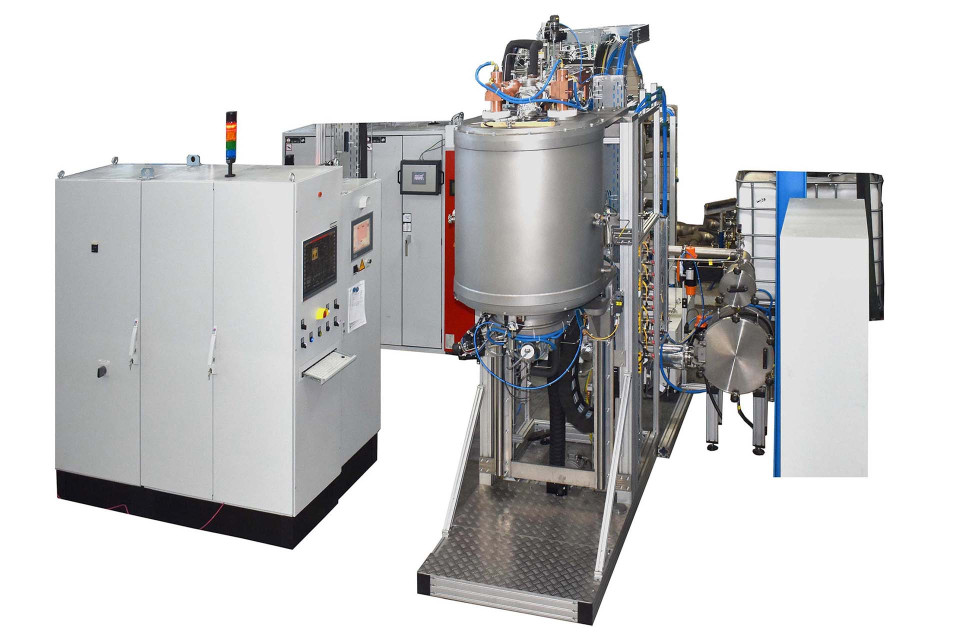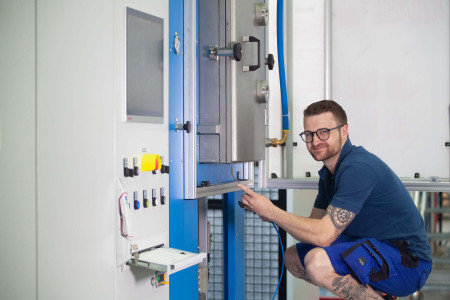CVD / CVI системы покрытия и инфильтрации
Тип CVD 30
Функции:
- Полезные габариты (Ø/h): 360 мм / 295 мм
- Полезный объем: 30 дм³
- Макс. объем загрузки: ≤ 25 kg
- Диапазон рабочих температур: 900 - 1500 °C
- Макс. температура: 1600°C
- Скорость нагрева (комнатная -1600°C): ≤ 5 К/ мин.
- Однородность температуры: ± 10 K
- Предельный вакуум (в холодной, чистой печи): ≤ 2x10-1 мбар (20 Па)
- Скорость утечки: ≤ 5 x 10-2 мбар л/с
- Диапазон регулирования парциального давления: 10 - 100 мбар
- Макс. доступная мощность нагрева: 45 кВт
- Потребность в охлаждающей воде (p_in: 4 бар): 30 кВт
- Требуемое пространство (Ш / В / Д): 5 / 3 / 3 м
- Требуемое напряжение питания: 3 x 380 В ± 5%, 50 Гц, 130 кВА
- Управление Siemens S7 / 1500 и WinCC
- Опция: нагреватель горелки
- Опция: испаритель
Производитель оставляет за собой право вносить изменения без уведомления

Description
Thermally induced chemical vapor deposition (CVD) is a powerful way of depositing homogeneous layers of various dielectric, semiconducting and metallic materials, either in monocrystalline, polycrystalline, amorphous or epitaxial state on small or large area substrates.
Typical coating materials include pyrolytic carbon, silicon carbides and boron nitrides. By using synthetic precursors, the coatings are extremely pure and meet the typical requirements of the semiconductor industry.
Depending on the process parameters, a wide range of layer thicknesses is possible, from single or a few atomic layers to solid protective or functional layers with a thickness ranging from a few nanometers to hundreds of micrometers and beyond to monolithic parts with a thickness of several millimeters.
Thermally induced chemical vapor infiltration (CVI) is a CVD-related technology for infiltrating matrix material into porous or fibrous preforms to produce composite parts with improved mechanical properties, corrosion resistance, thermal shock resistance and low residual stresses.
Complex shapes can be produced in a variety of sizes and compositions. By switching between multiple gas orifices, the porous or fibrous preforms can be coated with multi-layer interfacial coatings before the actual deposition of the matrix itself begins.
Functions
- Coating under atmospheric pressure ""AP-CVD"" or under relative pressure ""LP-CVD""
- High flexibility in process optimization and design
- Extensive data evaluation
- Prototype production, series production
- Design: bottom loader
- Temperature measurement using thermocouple and pyrometer
Main specifications
- Application temperatures up to 2200 °C
- Multi-zone heating
- rotating turntable
- exhaust gas aftertreatment
- Controlled separation and treatment of by-products
- Gas treatment and gas phase separation for SiC, Si3N4, BN and AlN
SiC: CH3SiCl3 → SiC + 3HCl
Si3N4: 3SiCl4 + 4NH3 → Si3N4 + 12HCl
BN: BCl3 + NH3 → BN + 3HCl
AlN: AlCl3 + NH3 → AlN + 3HCl
| CVD Standardtypes |
useful dimensions (Ø/h) [mm] | nutzbare Volume [dm3] |
max. load [kg] | max. Temperature [°C] |
max. heating power [kW] |
|---|---|---|---|---|---|
| CVD 30 | 360 x 295 | 30 | ≤ 25 | 1600 | 45 |
| CVD 175 | 530 x 800 | 175 | ≤ 100 | 1600 | 150 |
| CVD 900 | 900 x 1400 | 900 | ≤ 400 | 1600 | 300 |
| CVD 2500 | 1400 x 1700 | 2600 | ≤ 600 | 1600 | 500 |
| FS W 500-CVI | 1000 x 600 | 500 | ≤ 450 | 1600 | 300 |
Contact us directly

Any more questions?
Contact us!
We will be happy to answer your questions and advise you according to your requirements and areas of application.

